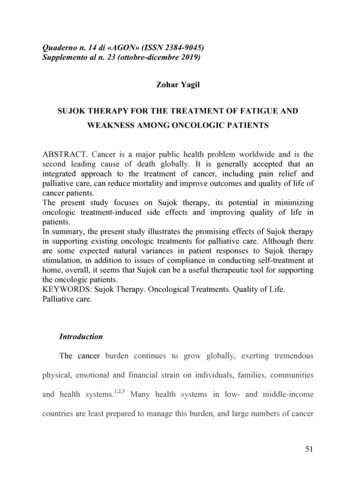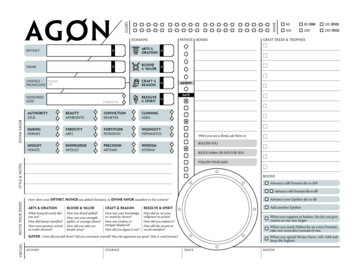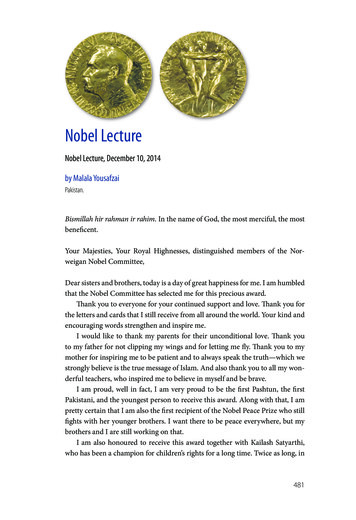
Transcription
Quaderno n. 14 di «AGON» (ISSN 2384-9045)Supplemento al n. 23 (ottobre-dicembre 2019)Zohar YagilSUJOK THERAPY FOR THE TREATMENT OF FATIGUE ANDWEAKNESS AMONG ONCOLOGIC PATIENTSABSTRACT. Cancer is a major public health problem worldwide and is thesecond leading cause of death globally. It is generally accepted that anintegrated approach to the treatment of cancer, including pain relief andpalliative care, can reduce mortality and improve outcomes and quality of life ofcancer patients.The present study focuses on Sujok therapy, its potential in minimizingoncologic treatment-induced side effects and improving quality of life inpatients.In summary, the present study illustrates the promising effects of Sujok therapyin supporting existing oncologic treatments for palliative care. Although thereare some expected natural variances in patient responses to Sujok therapystimulation, in addition to issues of compliance in conducting self-treatment athome, overall, it seems that Sujok can be a useful therapeutic tool for supportingthe oncologic patients.KEYWORDS: Sujok Therapy. Oncological Treatments. Quality of Life.Palliative care.IntroductionThe cancer burden continues to grow globally, exerting tremendousphysical, emotional and financial strain on individuals, families, communitiesand health systems.1,2,3 Many health systems in low- and middle-incomecountries are least prepared to manage this burden, and large numbers of cancer51
Quaderno n. 14 di «AGON» (ISSN 2384-9045)Supplemento al n. 23 (ottobre-dicembre 2019)patients globally do not have access to timely quality diagnosis and treatment. Incountries where health systems are strong, survival rates of many types ofcancers are improving thanks to accessible early detection, quality treatment andpalliative care.Palliative care is a treatment to relieve, rather than cure, symptoms causedby cancer and improve the quality of life of patients and their families. Palliativecare can help people live more comfortably. It is an urgent humanitarian needfor people worldwide with cancer and other chronic fatal diseases andparticularly needed in places with a high proportion of patients in advancedstages of cancer where there is little chance of cure.Relief from physical, psychosocial, and spiritual problems can be achievedin over 90% of advanced cancer patients through palliative care4.Sujok Therapy (Su-Jok) is a form of complementary medicine originatedin South Korea in 1987 by the scientist and scholar Prof. Park Jae Woo5-8In Sujok therapy, the practitioner stimulates points that are located on thehand and foot in order activate auto-regulatory mechanisms and restore the bodyto a healthy state.952
Quaderno n. 14 di «AGON» (ISSN 2384-9045)Supplemento al n. 23 (ottobre-dicembre 2019)The stimulation of the curative points can be performed by non-penetrativeapproaches such as massage, color therapy, moxibustion, plant seeds10, magnets,soft laser, aromatic oils, gem stones as well as needles and other devices.Clinical studies and case reports regarding the efficiency and efficacy ofSujok therapy were previously published for the treatment of various conditionsfrom chronic pain11-13,14,13, pain due to disc herniation15-16 and migraines17-19, tocomplexed conditions such as asthma20-21, and even rehabilitation from stroke22and comatose conditions23, 24.Sujok therapy is easy to administer, cost efficient and was originallydeveloped as a system for the use of individuals for self-treatment.25,9We decided to investigate the possible use of Sujok therapy to supportoncologic patients as a complementary method of palliative care. This study wasfocused on quality-of-life–related outcomes and reducing the symptoms offatigue and weakness that are common side effects of the oncologicaltreatment.2653
Quaderno n. 14 di «AGON» (ISSN 2384-9045)Supplemento al n. 23 (ottobre-dicembre 2019)Materials and MethodsStudy DesignThe study was designed as a descriptive survey, with the goal of evaluatingthe possible effect of Sujok therapy on side effects of oncologic treatments. Thestudy was conducted at the Israeli Chapter of the International SujokAssociation (ISA-Israel), between 2015 and 2019.Inclusion CriteriaThe study questionnaires were given to oncologic patients that approachedISA-Israel for Sujok treatments in order to treat symptoms caused by theoncologic treatments.The patient group included 258 cancer patients in various stages of thedisease aged between 32 and 78.Questionnaires were filled up by the patients before the first treatment andafter 12 Sujok treatments.Sujok treatments included a procedure once or twice a week as well asinstructions for self-treatment by stimulation of correspondence points at home.54
Quaderno n. 14 di «AGON» (ISSN 2384-9045)Supplemento al n. 23 (ottobre-dicembre 2019)Questionnaire DesignFor the design of the study tool a PubMed-Medline search was conducted,using the keywords: “Cancer treatment side effects”, “Oncologic treatment sideeffects”, “Cancer patients quality of life”.A specific questionnaire was designed based on long term and latent sideeffects of the oncologic treatments. Long-term effects are side effects that ariseduring the treatment and may persist over time, whereas latent effects may notappear until many years after treatment completion.26In order to evaluate the patients’ well-being, factors from the WHODisability Assessment Schedule 2.027 were included in the questionnaire.Statistical AnalysisThe findings from the data were compiled in a Microsoft Excel table(Windows 2010) and presented as mean of the scoring values. The qualitativeanalysis of patients’ narratives, appearing as 2 open-ended questions andcomments in the “others” option of the multiple-choice questions, were analyzedusing a content analysis method.2855
Quaderno n. 14 di «AGON» (ISSN 2384-9045)Supplemento al n. 23 (ottobre-dicembre 2019)EthicsAll respondents in this study participated on a purely voluntary basis andprovided informed consent following oral as well as written explanation of theresearch methodology and goals.All patients were required to pay for the treatments themselves.The research design and study were conducted according to the ICH-GCPand the IEC rules and regulations.ResultsComplaints of common side effects following oncologic treatmentsDuring 2015-2019, 258 oncologic patients who visited the ISA Israel clinicagreed to participate voluntarily in our survey. Gender, age, type and duration ofdisease were collected as well as the medical procedure and the complaints ofoncologic treatment side effects.As shown in figure 1, the most common side effects which were reportedwere fatigue (80% of the patients) as well as depression (80% of the patients)and weakness (63% of the patients), sleep disorders (60% of the patients) and56
Quaderno n. 14 di «AGON» (ISSN 2384-9045)Supplemento al n. 23 (ottobre-dicembre 2019)general pain (45% of the patients). Percentage of patients who reported on thevarious symptoms are presented in Figure 1.258 patients participated in this study. All patients were interviewed in the beginning of thecourse of Sujok treatments and asked to report the side effects that they suffered from. Thenumbers of the patients reporting different side effects such as depression, weakness,diarrhoea and pain among others are shown in the table.57
Quaderno n. 14 di «AGON» (ISSN 2384-9045)Supplemento al n. 23 (ottobre-dicembre 2019)Effect of Sujok therapy on FatigueFatigue is the most common symptom experienced by oncologic patients,with prevalence rates ranging from 15-30% to 70-99%.29,30 Cancer-relatedfatigue may remain for years after treatment. Mechanisms for persistent fatigueamong cancer survivors are not yet fully understood; several pathways,including chronic inflammation, autonomic imbalance, hypothalamic-pituitaryadrenal-axis dysfunction, and mitochondrial damage, may cause disruption ofnormal neuronal function and result in fatigue.31 Physical activity has beenshown to improve fatigue symptoms.32 In order to evaluate the effect of Sujoktherapy among oncologic patients, the feedback of 206 patients was collectedbefore and after Sujok treatments. General improvement of fatigue wasevaluated in the scale of 0-10 where 10 is the highest level of fatigue that standsfor exhaustion and inability to perform daily tasks and 0 is no fatigue at all.As shown in figure 2, a considerable decrease in the level of fatigue wasreported following Sujok treatment. The mean level of fatigue before treatmentwas 7.59 2.18, which was reduced to 3.11 1.4 after 12 Sujok treatments.58
Quaderno n. 14 di «AGON» (ISSN 2384-9045)Supplemento al n. 23 (ottobre-dicembre 2019)The feedback of 206 patients was collected before and after Sujok treatments. Generalimprovement of fatigue was evaluated in the scale of 0-10 when 10 is the highest level offatigue that stands for exhaustion and inability to perform daily tasks and 0 is no fatigue at all.Data presented is the mean of fatigue levels before Sujok treatments (7.59 2.18) compared tothe mean levels of fatigue reported by the patients after 12 Sujok treatments (3.11 1.4).Effect of Sujok therapy on the level of weaknessCancer cachexia is a complex metabolic condition characterized by skeletalmuscle wasting (with or without fat loss), anemia, reduced caloric intake, andaltered immune function, which contributes to increased disability, fatigue,diminished quality of life (QoL), and reduced survival.3359
Quaderno n. 14 di «AGON» (ISSN 2384-9045)Supplemento al n. 23 (ottobre-dicembre 2019)In order to evaluate the effect of Sujok therapy on general reports ofweakness, Feedback from 162 patients was collected before and after 12 Sujoktreatments.As shown in figure 3, a considerable decrease in the level of fatigue amongcancer patients was reported following 12 Sujok treatments.The feedback of 162 patients was collected before and after Sujok treatments. Generalimprovement of weakness was evaluated in the scale of 0-10 when 10 is the highest level ofweakness that stands for exhaustion and inability to perform daily tasks and 0 is normalstrength and ability to perform daily tasks.The data represent the mean of weakness levels before Sujok treatments (7.55 1.31)compared to the mean levels of weakness reported by the patients after 12 Sujok treatments(2.9 1.81).60
Quaderno n. 14 di «AGON» (ISSN 2384-9045)Supplemento al n. 23 (ottobre-dicembre 2019)General satisfaction for the Sujok treatmentsDue to the scope of this article, that focuses on the possibility to use Sujoktherapy as palliative care for oncologic patients and due to heterogeneity of ourstudy group, one of the most important qualitative question concerns thepatients’ satisfaction on the basis of the results achieved by the Sujok treatment.Generally,patientsapproachedour clinic voluntarily in order torelievetheseverityoftheirsymptoms. As shown in Figure 4,most of the patients were satisfiedwith the outcome of the Sujoktreatments suggesting that Sujokcan be a beneficial form to treatthe fatigue and weakness inducedby the oncologic treatments.258 cancer patients were interviewed as to their general satisfaction of the outcome of theSujok treatments. On a scale of 1-10, as shown, most patients were satisfied from thetreatment outcomes (reported more than 75% improvement) while only 10% reported lessthan 50% improvement.61
Quaderno n. 14 di «AGON» (ISSN 2384-9045)Supplemento al n. 23 (ottobre-dicembre 2019)Will the patient recommend other oncologic patients to try Sujoktreatment?Sujok therapy as a complementary form of medicine is practiced by privatetherapists and doctors and not as a part of the conventional health system.Finally, we asked the patients if they would recommend friends and fellowpatients to try Sujok therapy and would they like to receive Sujok treatments aspart of the health services offered by the local health system. As shown infigures 4 and 5, more than 95% of patients will recommend to try support by theSujok therapy method and would like to receive Sujok treatments within thepublic health care system.Percentage of patients that will recommand onSujok treatments to other oncologic patientsNo3%Yes97%YesNoFigure 5: Percent of patients that will recommend other oncologic patients to try Sujoktherapy.258 patient responses were collected through the survey. 97% chose the option to recommendothers while only 3% stated that they will not recommend others.62
Quaderno n. 14 di «AGON» (ISSN 2384-9045)Supplemento al n. 23 (ottobre-dicembre 2019)Percent of the patients that would like toreceive Sujok treatment within the publichealth care system.4%96%YesNoFigure 6: Percent of the patients that would like to receive Sujok treatment within thepublic health care system.Responses from 258 patients were noted. 96% noted that they would like to receive Sujoktreatments within the public health care system while 4% noted that they have no suchrequest.DiscussionWhile medical treatment has improved cancer outcome in the majority ofthe patients with early-stage disease, the recovery comes at the cost of sideeffects. These side effects are the unavoidable hazard of anti-cancer chemotherapy and include both immediate and late effects such as nausea andvomiting, constipation, fatigue, depression, infections, hair loss and sexualdysfunction and infertility.The majority of the cancer survivors experience long-term effects ofchemotherapy including those appearing many years after treatment completion.63
Quaderno n. 14 di «AGON» (ISSN 2384-9045)Supplemento al n. 23 (ottobre-dicembre 2019)These side effects are distressing and debilitating for the patients. Weinvestigated long-term efficacy of a complementary therapy (Sujok) for thealleviation of treatment-associated side effects of several types of plementary/integrative medicine (CIM) into conventional supportive andpalliative care in many leading oncology centre
approaches such as massage, color therapy, moxibustion, plant seeds10, magnets, soft laser, aromatic oils, gem stones as well as needles and other devices. Clinical studies and case reports regarding the efficiency and efficacy of Sujok therapy were previously published for the treatment of various conditions from chronic pain11-13,14,13, pain due to disc herniation15-16 and migraines17-19, to .











